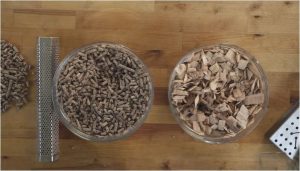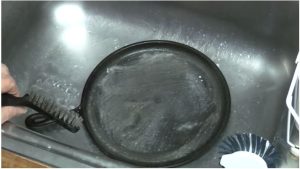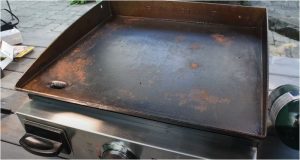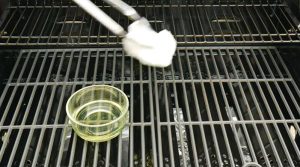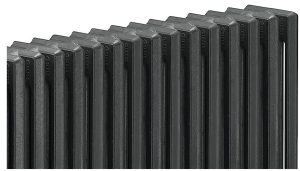Smoke Signals: Good Smoke Vs. Bad Smoke BBQ
Good smoke from a barbecue grill is blue or white in color, while bad smoke is black or gray.
Blue or white smoke indicates that the fire is burning cleanly and efficiently, producing smoke that carries more flavor into the food. Black or gray smoke means the fire has excess fuel or air, producing acrid, bitter smoke that can make food taste unpleasant.
To produce good smoke for barbecuing, start with dry, seasoned hardwood chunks or chips. Light the fire with kindling and let it burn down to hot coals before adding the wood. The wood should begin to smolder and produce thin blue or white smoke within a few minutes.
If you see thick black smoke, the fire is too hot and you need to reduce the airflow or remove some of the coals.
Once you achieve clean, blue, or white smoke, position the food over the fire or inside the smoker. Monitor the smoke color periodically; if it begins to turn black, make adjustments to restore clean burning.
Food cooked with blue or white smoke will absorb more of the subtle, complex flavors from the wood.
In contrast, black or gray smoke can leave a bitter aftertaste and reduce the overall quality of the barbecue. With practice, patience, and the right fire management techniques, you can achieve the ideal “good smoke” needed for a flavorful, delicious barbecue.
Differentiating Smoke Quality: Key Factors in BBQ
Good and bad smoke in barbecue comes down to the quality of the smoke produced by the fire or smoker. Some factors determine whether the smoke will impart desirable flavor or unpleasant bitterness to the food.
The color of the smoke indicates its quality, with blue or white smoke signifying clean, efficient burning and black or gray smoke meaning excess fuel or air in the fire. Blue or white smoke carries more flavor compounds into the food while black smoke contains bitter elements.
The type of fuel also matters – hardwood chunks or chips produce better smoke than construction lumber or treated wood.
Seasoned hardwood that has been dried and aged for at least 6 months burns the cleanest. Green or unseasoned wood can generate creosote and bitter smoke.
The heat of the fire impacts smoke quality, with lower temperatures below 300 degrees Fahrenheit favoring clean burning. Higher temperatures above 500 degrees can cause wood to pyrolyze and produce black smoke. Proper airflow and fire management are needed to control the heat.
The duration of the smoking process also affects flavor, as smoke absorbed in the first 60 to 90 minutes contributes to the majority of the smokiness.

Is white smoke bad for smoking meat?
While white smoke from a barbecue grill or smoker can indicate clean burning, it does not necessarily mean the smoke is ideal for flavoring food. White smoke on its own is not necessarily bad, but it is a sign that the fire may need adjustment to produce blue smoke for the best results.
White smoke occurs when the fire is burning too coolly, with excess airflow and not enough fuel. This can happen when first lighting a smoker or after adding fresh wood chips or chunks.
The white smoke indicates that the wood is still drying out and heating up, rather than actually combusting.
1. The problem with white smoke is that it tends to contain more moisture and less of the aromatic compounds that provide flavor.
2. Meats smoked during the white smoke phase will absorb less smoke flavor compared to smoking with blue smoke.
3. White smoke can also mean incomplete combustion of the wood, which can produce chemicals that impart bitter or acrid flavors.
4. While not necessarily harmful, white smoke is often a sign that the fire or smoker’s temperature needs to be increased to produce the blue smoke optimal for flavor.
Read Also: Meat Placement Perfection: Arrange Your Vertical Smoker
Wood Selection and its Impact on BBQ Smoke
The choice of wood plays a significant role in the quality of smoke produced during barbecuing. Different types of wood impart distinct flavors, and the quality of the wood itself can affect the smoke’s color and aroma.
1. Hardwoods like oak, hickory, and apple are often preferred for smoking because they burn slowly and produce rich, flavorful smoke. Softwoods burn too quickly and can produce an overpowering smoke that may not be as pleasant.
2. The condition of the wood is also crucial. Seasoned wood, which has been dried for at least six months, burns cleaner and produces a better smoke than green or unseasoned wood.
3. Using wood that is too wet can lead to black smoke, which is less desirable for flavoring food. Dry wood, on the other hand, produces the ideal blue or white smoke.
Achieving Perfect Smoke: Temperature Control and Techniques
Temperature control is key to achieving the perfect smoke for barbecuing. The heat of the fire affects the combustion of the wood and the quality of the smoke produced.
1. A fire that is too hot can cause the wood to burn too quickly, producing black smoke and a bitter flavor. On the other hand, a fire that is too cool may not fully combust the wood, leading to white smoke and less flavor.
2. Maintaining a consistent temperature between 225 and 250 degrees Fahrenheit is often recommended for smoking meat. This allows the wood to smolder rather than burn, producing a steady stream of flavorful smoke.
3. Techniques for controlling temperature include adjusting the air vents on the grill or smoker, adding or removing coals, and monitoring the fire regularly.

Evaluating Smoke Quality: Fuel, Intensity, and Consistency
The quality of smoke in barbecuing can be evaluated based on the type of fuel used, the intensity of the smoke, and its consistency.
1. As mentioned earlier, the type of wood used as fuel can greatly affect the smoke’s quality. Hardwoods produce a better smoke than softwoods, and seasoned wood is preferable to green wood.
2. The intensity of the smoke is also important. A thin, blue, or white smoke is ideal, as it indicates clean combustion and carries more flavor. Thick, black smoke is a sign of incomplete combustion and can impart a bitter taste to the food.
3. Consistency in smoke production is crucial for flavoring the food evenly. A steady stream of smoke throughout the cooking process ensures that the food absorbs the smoke flavor consistently.
FAQs
What color should the smoke be when smoking meat?
The smoke should ideally be thin and blue when smoking meat. This indicates that the wood is burning at the right temperature and the meat is being smoked properly. Thick, white smoke can lead to a bitter taste.
What does blue smoke look like?
Blue smoke is thin and almost invisible. It’s much lighter than white or black smoke and can sometimes be difficult to see unless you’re looking for it. It’s a good sign when smoking meat, indicating optimal combustion and temperature.
How can I get blue smoke from my smoker?
To get blue smoke from your smoker, ensure that your wood is dry and your smoker is at the right temperature. Too low a temperature can create white smoke, while too high can create black smoke. Adjusting the air vents can also help control the smoke color.
How can I get clean smoke for BBQ?
Clean smoke can be achieved by maintaining a consistent temperature in your smoker and using dry, seasoned wood. Avoid using green or wet wood as it can produce thick, white smoke. Also, ensure proper ventilation to avoid the buildup of smoke.
Why does black smoke occur when smoking meat?
Black smoke can occur when the temperature in your smoker is too high or when there’s not enough ventilation. It can also be a result of burning fat drippings or using wood that’s not properly seasoned. Black smoke can give your meat a bitter taste.
Why does my smoker produce dirty smoke?
Dirty smoke, often thick, can be produced if your smoker is not properly ventilated, if the temperature is too low, or if you’re using green or wet wood. This type of smoke can result in a bitter flavor in your smoked meat.

